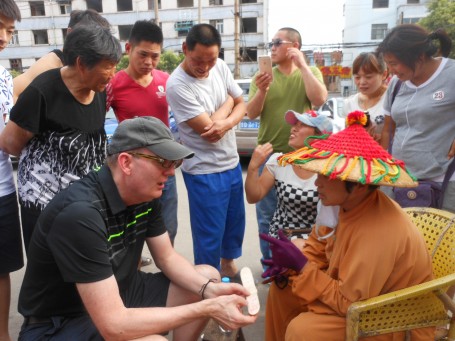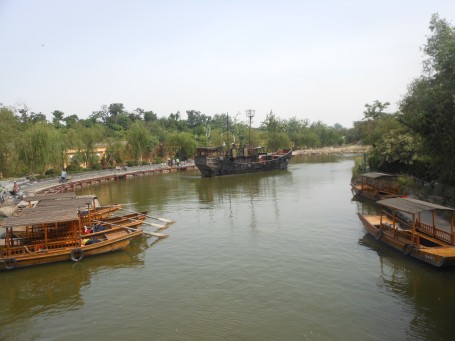By: Jon Peppin, Psalm Chang, & Michelle Ngan
Wow. This city of 700,000 people is so precious. We love how close to “authentic” it’s been (although “authentic” does not exist) and how it’s not tainted with tourists as much as Beijing was. It’s been a great three days- we visited many temples and theme parks that gave us more of a sense of the culture here, and are thankful for the experience thus far. These places as well as the free time have been especially beneficial to us in terms of our fieldwork, as they are so rich with religious display.
At the Digital Plaza, we were able to use our Chinese skills and talk to two young sales girls. We showed them the “Mo Shou Lin Lin” (fortune telling app), to which they remarked that they never heard of it, but rather, thought that a “Feng Shui” app was more widely used and accurate. Thanks to Professor Sheehan, we were able to get the addresses of two local temples, one Daoist and one Buddhist, that a salesperson recommended for fortune telling. Our spontaneous adventures continued from there!
At the Daoist Temple, we were presented with mixed messages about fortune telling––while the salespeople at the Digital Plaza had told us that there was fortune telling at the temple, once we were there, employees told us that there was no fortune-telling. Eventually, one woman, in a hushed tone barely audible to the foreign ear, admitted that there was a fortune-teller, but alas, that he was a scammer. We tried to go meet the fortune teller, but employees blocked our path to his room and told us that the area was reserved for employees, although from our spot, we could see temple-goers inside the mysterious room. Suspicious much?
Undeterred, we continued on our path to search for fortune-tellers and walked to the Buddhist temple. There, we found several fortune-tellers right outside the temple. Eventually, we found one woman sitting outside the temple. Papa Sheehan volunteered to have his fortune told (we’re grateful, because we definitely would not have been able to completely understand without his translation). He chose to have his wealth fortune told, and according to her, he would have the luckiest future ahead of him.
In terms of our research, our escapades to the Daoist temple and fortune-tellers spoke especially to our research topic. As Professor Sheehan described after, many fortune-tellers’ prices are contingent on the fortune that is told––good fortune equals high price, bad fortune equals bad price. This practice reflects the commodification of religious practices, and speaks to the conflation between religious ideas and consumer behavior, as consumers will pay differing prices for different fortunes, as if selecting a product from a shelf of selections.
Onto today’s events! Our day started off with a visit to a “theme park”––not the theme park that we Americans would normally think about, but rather a park with an overarching theme. In this case, the gargantuan park was based entirely off a five-meter painting of Song dynasty Kaifeng. There was so much to see and to do. We saw a lot of animals, for one thing. There was a camel, a goat and a monkey, and horses (whom we could definitely smell). While one group won prize after prize at the carnival games, the others frequented the myriad of shows that the park had to offer––from a fire-spitter spewing forth a tumultuous gulf of fiery chaos (that nearly took off our hair and head) to an animated joust fought between numerous martial arts masters. Our day at the park was a truly exceptional experience that will not be forgotten anytime soon. KAIFENG ROCKS!!!!



